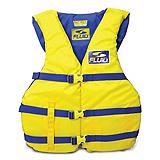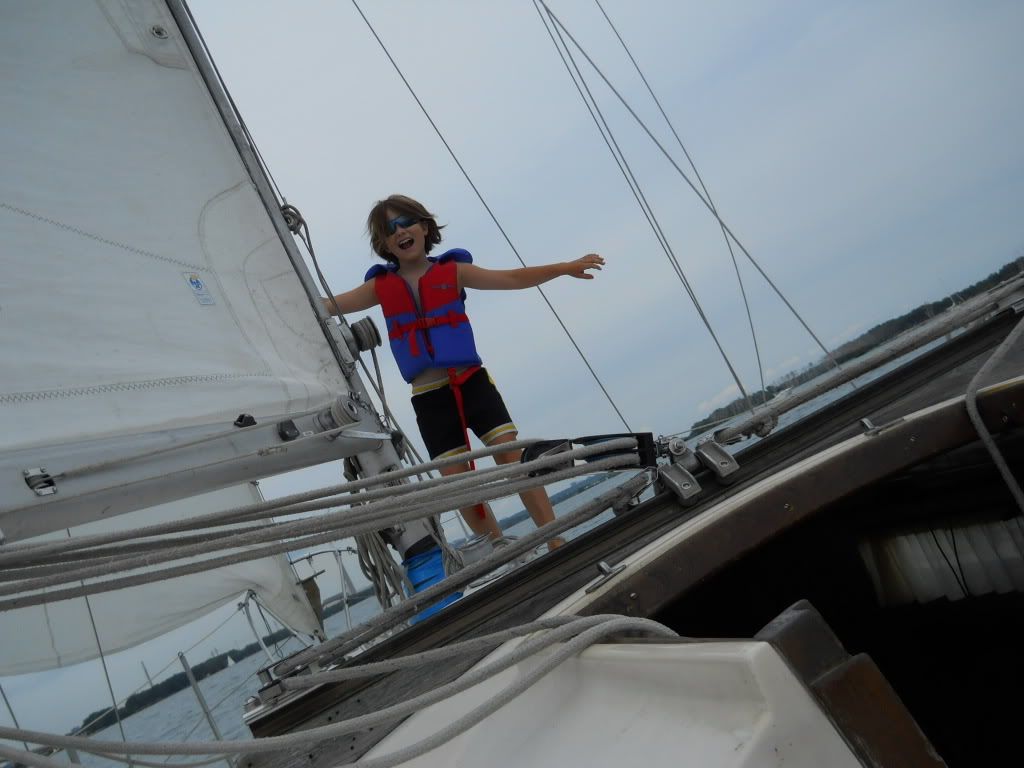 Meet Starboard McStainless, the 100 gallon water tank I hauled out yesterday. Nice piece of work, yes? Inspection port, threaded outlets and inlets, an internal baffle, very little in the way of scratches or rust. Why would I want to yank such a nifty tank out of the bilges of Alchemy, one might ask. And, with dimensions of 48 x 24 x 20 inches, and an engine room hatch of 48 x 24 inches, would I perform Moebius-strip contortions to get this beast out? (Not to mention the removal of the pilot house roof and the use of a truck crane?). It came out, in the end, fairly smoothly, although grabbing the thing in yesterday's high winds as I yelled instructions to the invisible crane guy via another guy on the side deck was quite stimulating.
Meet Starboard McStainless, the 100 gallon water tank I hauled out yesterday. Nice piece of work, yes? Inspection port, threaded outlets and inlets, an internal baffle, very little in the way of scratches or rust. Why would I want to yank such a nifty tank out of the bilges of Alchemy, one might ask. And, with dimensions of 48 x 24 x 20 inches, and an engine room hatch of 48 x 24 inches, would I perform Moebius-strip contortions to get this beast out? (Not to mention the removal of the pilot house roof and the use of a truck crane?). It came out, in the end, fairly smoothly, although grabbing the thing in yesterday's high winds as I yelled instructions to the invisible crane guy via another guy on the side deck was quite stimulating.
But why? Well, here's the deal. The sibling to this tank, Porty McStainless, is identical, save for a top end hose barb that takes the deck fill hose, which snakes torturously through a tool locker to reach the break in the deck. The fill routine consisted of filling this port tank to overfilled status, at which point a hose would fill the starboard tank. When were they both filled? When the boat stopped listing and water came out the starboard vent.
The shortcomings of this method were many. Worse, however, from my point of view, is that these tanks are (or were) mounted on angle iron a good two feet off the hull. Filled tanks, or worse, ONE filled tank, actually made my steel boat a trifle tender, because the weight was too high. In somewhat heavy seas in 2007 (yes, Lake Ontario can throw up the occasional eight to 10 footers if it's been blowing 30 knots all day from the east or south-east), these tanks BOOMED as they flexed and sloshed as the boat pitched forward and back.
The baffles, they did nothing.
Lastly, those fine inspection ports were on the TOPS of the SS tanks...within one inch of the underside of the pilothouse deck. Unless one was willing to unbolt the tanks, take apart the hoses, remove the engine and yanks the tanks under the hatch, nothing was ever going to get inspected.
Well, that's not going to work, is it?
So I decided that I wanted to improve my boat's "stiffness" by getting the water tankage (which is the better part of one tonne and is "non trivial" in terms of ballasting the hull) lower, resting just off the hull in through-bolted angle iron supports (the bit I liked), and placed between the frames. For ease of handling and management and even for trim purposes, I'm opting for four approximately 50 gallon water tanks, made of HDPE, ideally. They will be small enough not to require baffles, and low enough to keep the weight where it should be, as close to the keel as is possible.
 Something like the above, times four. Inspection ports are at knee height, all hose fittings are accessible, there is now air above for hanging awkward light stuff like fenders, pipe and lengths of hose (all secured, of course).
Something like the above, times four. Inspection ports are at knee height, all hose fittings are accessible, there is now air above for hanging awkward light stuff like fenders, pipe and lengths of hose (all secured, of course).
Why four tanks? Aside from the insurance that if one tank goes "bad", there's three others, we intend to get a smallish watermaker. The idea is that one tank will hold collected rainwater for "wash" water, water used to clean the boat, flush the head (a Y-connection allowing a freshwater flush or three of the head will get rid of many of the critters and sediments that would otherwise clog the works...apart from the usual traffic that can clog the works...), and do the onboard laundry.
The other three tanks would contain either trusted "municipal" water, or water we make ourselves while motoring in clean seawater. One of the reasons for having a double PTO on the new engine is to run twinned alternators to charge maximally the house bank when underway for the weekly holding tank pumpout, for instance. (Note to self. Make fresh water AWAY from pump out zone...ewwww....)
I will install two water fills (there is evidence one used to be on starboard, but is mysteriously under a welded plate), and will rationalize the tank vents so that even a capsize would be unlikely to put salt water in the tanks. I will also plumb these tanks so that I can pump water between them to keep the weight either high side on long reaches in trade winds, or to keep it in the forward two tanks for better balance.
Lastly, I will have foot pumps (I like the Whale type) plus pressure water in the galley. The galley will have the existing "domestic" tap set (pressure hot potable water from the hot water tank and the Flojet pump) and potable foot pumped water, and lastly, a hand-pumped seawater tap for "utility" wash ups.
It sounds complicated and expensive, certainly, but the decision to go with plenty of water tankage (it's the same amount in a different configuration, really), and a watermaker was not taken lightly, and is prompted by the same "shore-independent" set up that is driving the multiple charging sources design and the somewhat oversized battery bank capacity.
Everything's relative, of course. I understand 840-1000 Ah is not, in fact, as big as many folk with more amp-greedy gadgets than I plan to install already have.
Like this times three:

I just want to run my fridge and make the occasional SSB foray and netbook charging for five cloudy, windless days at anchor without thinking "damn, I have to fire up the diesel to make amps".
By the same token, 150 gallons of drinking water is considerable for three humans, even in the tropics. The ability to make it from the sea using amps made from the wind and the sun? Priceless.
Now, to get Porty out...
UPDATE August 22, 2011: The fine fellow who purchased the starboard tank phoned me to ask if I would trade it for the port tank (identical in size but the mirror image in plumbing fixtures).
So up it came. "Identical" in custom-made boat gear is a relative concept, as the tank proved about a quarter-inch wider than the hole in the pilothouse floor. Snug wasn't the half of it.
 Anyway, using brute strength, 3D mental visualizations, and the Amazing Folding Wife, we managed to crane out the thing standing on its end, and away it will shortly go.
Anyway, using brute strength, 3D mental visualizations, and the Amazing Folding Wife, we managed to crane out the thing standing on its end, and away it will shortly go.
Now, to find a buyer for a starboard SS water tank!










